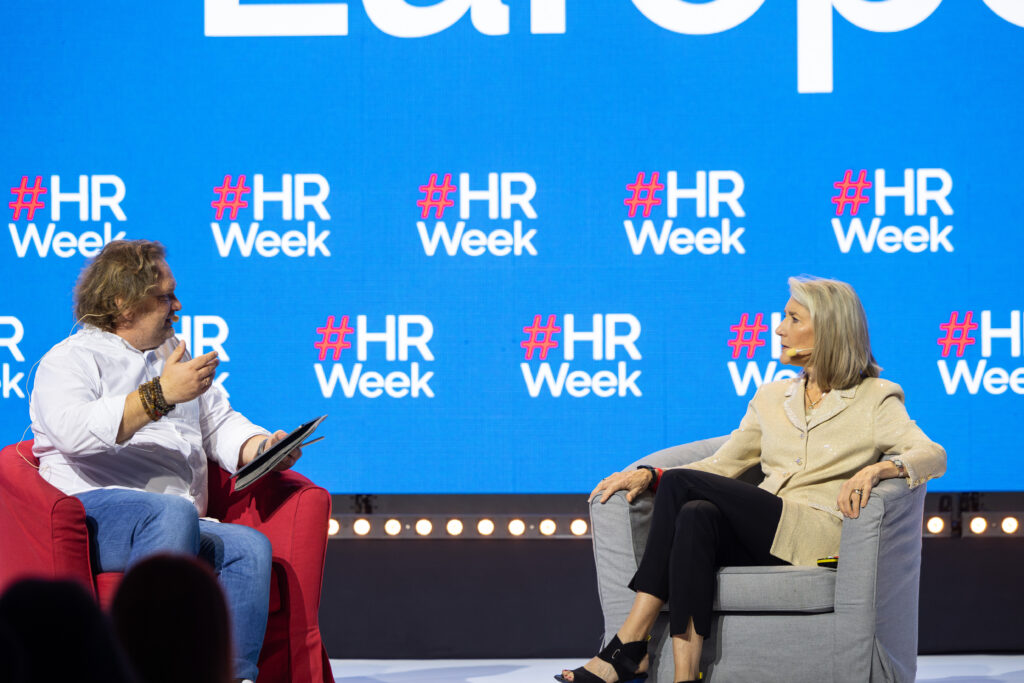Psychological Safety Isn’t About Being Nice, It’s About Learning to Win.
A conversation with Dr. Amy Edmondson at HR WEEK Europe
Dr. Amy Edmondson during her keynote at HR WEEK Europe
Thank you for being here with us today. It’s always a pleasure to hear your insights on psychological safety. You’ve mentioned in the past that the topic is close to your heart. How did this all start for you?
It started with a dramatic failure. When I was a PhD student, I wanted to show a very simple hypothesis: that better teams in hospitals would have fewer error rates. I was measuring team properties with a survey, and trained medical investigators were collecting error data every other day for six months. I was running correlations to show that teamwork would produce fewer errors, but I was wrong. The data suggested a statistically significant relationship between teamwork and error rates, but in the wrong direction. The better teams seemed to have higher, not lower, error rates.
After contemplating dropping out of school and thinking I was a failure as a researcher, it suddenly occurred to me: maybe the better teams weren’t making more mistakes; maybe they were just more willing to report them. These errors need to be caught and corrected before anyone is harmed. If you’re a good, well-led team, you’re going to speak up honestly. But if you’re scared of the boss and worried about being blamed, you’ll hide them—and it’s not that hard to do.
From there, it was a long journey to demonstrate that this was true. I had to figure out how to measure it, confirm that it varied across teams, and ultimately prove that it predicted performance. The answer to all those questions, after a long journey, was yes.

Edmondson explaining psychological safety
What Psychological Safety Is and Isn’t
Your work has really brought psychological safety into the mainstream, but with that attention has come a lot of misunderstanding. Could you clarify what it is and, perhaps more importantly, what it isn’t?
Psychological safety is the belief that your team or environment is safe for taking interpersonal risks like speaking up with an idea, a question, a concern, or even a mistake. Please hear this: it doesn’t mean these things are easy, fun, or comfortable. It means you believe they are expected and welcomed by your team because of what’s at stake. It’s a sense of permission for candor.
Now, here are a few of my least favorite misunderstandings. Psychological safety is not about being nice. It’s not a guarantee that all of your ideas will prevail. It’s not a license to whine and hope someone else fixes your problems. Most importantly, it’s not about being comfortable. When people say, “You can’t give me feedback; it takes away my psychological safety because I find it uncomfortable,” they’ve got the wrong concept. Psychological safety describes a learning environment, and learning can be awkward, painful, and a stretch.
Psychological safety also isn’t about lowering performance standards. It’s a both/and question, not an either/or. Your responsibility as a leader is both to create permission for candor and to inspire high standards. When both of these are high, we enter what I call the learning zone or high-performance zone. This is where we’re motivated to do our very best work, and we understand that what we do is too uncertain and important to hold back. We’re willing to lean in.

Referencing Alan Mulally’s leadership story at Ford
The Leader’s Toolkit: Framing, Inviting, and Responding
So, how can leaders and team members actually build this kind of environment? You’ve identified a three-step toolkit. Can you walk us through it?
The three steps are simple, though not always easy: framing the work, inviting participation, and responding productively.
- Framing the Work: This means building a new, shared understanding of the work your team is doing. For instance, in an innovation company like IDEO, the CEO might say, “Fail often to succeed sooner.” He understands that the high-achievers he’s hired are emotionally allergic to failure, so he needs to constantly remind them that this work requires bold risk-taking. In a hospital, a leader might reframe patient care by saying, “Healthcare is, by its very nature, a complex, error-prone system.” This signals that when you speak up, you’re not pointing fingers; you’re saving lives. In manufacturing, a plant manager might reframe problems as a team sport, telling a manager, “Tell us about your problems so we can work on them together.”
- Inviting Participation: Once you’ve set the stage, you have to be proactive. A good question is the most important tool here. These aren’t just open-ended or leading questions; they’re focused on the issue but leave room for careful thought. They come in two buckets: those that help you go broad (“What are we missing? Who has a different perspective?”) and those that help you go deep (“What leads you to think that? Walk us through your thinking.”).
- Responding Productively: This is crucial. When someone takes you seriously and shares a concern or bad news, you have to respond well. The key is to be both appreciative and forward-looking. My favorite example is from Alan Mulally at Ford. When a senior executive finally shared a serious problem, Mulally applauded and said, “Thank you for that clear line of sight. How can we help?” The room’s culture of fear was immediately broken. That conversation took 12 seconds, but it changed everything. You have to make sharing honesty a positive experience because it isn’t one naturally.
That’s an incredibly clear and actionable framework. Have you ever doubted the importance of psychological safety?
I’ve doubted many times that it’s possible to systematically build these learning environments. There’s so much in human and organizational nature that goes against this goal. We are so set up to thrive in the industrial era. To suddenly say, “We can learn together, and we can be honest and humble and curious,” is just hard. So I’ve doubted whether it’s actionable more than I’ve doubted whether it’s true.

A moment from the on-stage conversation: Dainius Baltrusaitis in conversation with Dr. Amy Edmondson
The Future of Psychological Safety
You’ve dedicated so much of your career to this. What do you see as the next step for psychological safety?
We’ve seen from countless studies that psychological safety is consistently linked to team performance, and the effect is even stronger when the work depends on problem-solving, creativity, and ingenuity. So we know what matters, but the future is about the how. How do we give people the skills to apply this? These are interpersonal skills, not a magic button. We need to train people to be humble, curious, and empathetic, but also driven and motivated. Interpersonal skills have always been hard to train at scale, but with new AI and other platforms, we’re seeing new tools that can help.
The goal is to help every single employee in every organization show up as a fallible human being who is willing to be a great team member. We need to help us fallible human beings develop the skills we badly need to thrive in an uncertain world.
Thank you, Dr. Edmondson, for your time and insights.
My pleasure. Thank you.

